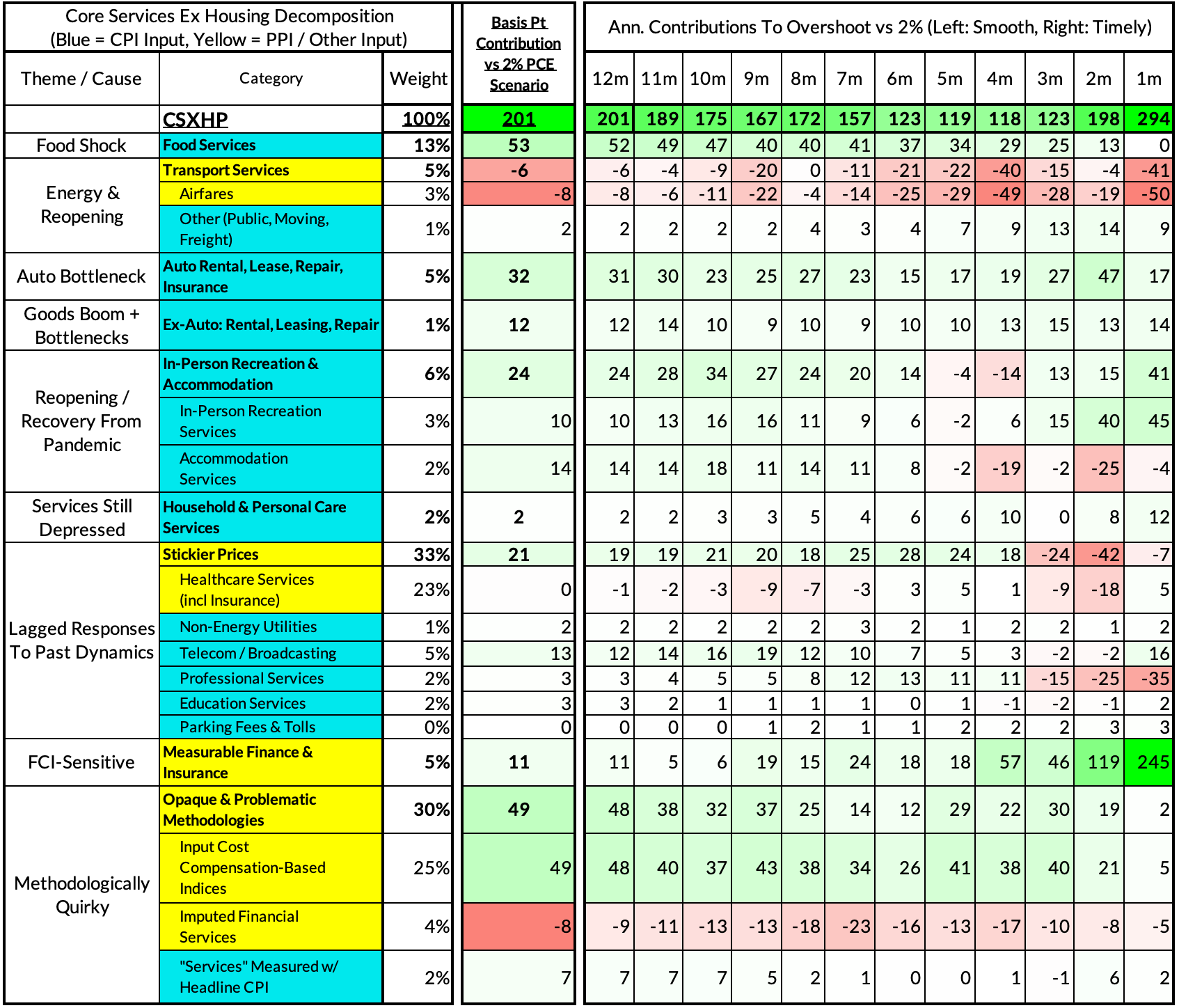Core-Cast is our nowcasting model to track the Fed's preferred inflation gauges before and through their release date. The heatmaps below give a comprehensive view of how inflation components and themes are performing relative to what transpires when inflation is running at 2%.
Most of the Personal Consumption Expenditures (PCE) inflation gauges are sourced from Consumer Price Index (CPI) data, but Producer Price Index (PPI) input data is of increasing relevance, import price index (IPI) data can prove occasionally relevant. There are also some high-leverage components that only come out on the day of the PCE release.
Table of Contents
- Summary
- Takeaways - Encouraging Inflation Outcomes, But Watch Out For The Wedge Between Core CPI & PCE From Here
- For the Detail-Oriented: Core PCE Heatmaps
- For the Detail-Oriented: Core Services Ex Housing PCE Heatmaps
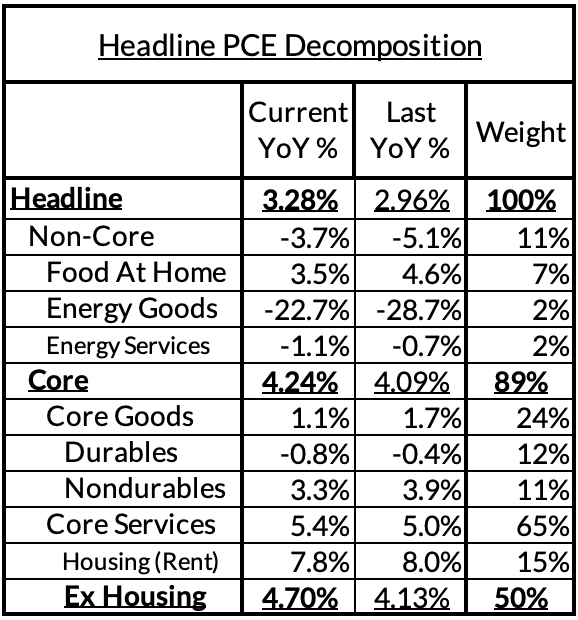

Summary
The Fed's 3.9% Y/Y Core PCE projection looks increasingly high versus recently realized Core PCE outcomes, and we have yet another print that adds momentum to for core PCE to reach 2% on a year-over-year basis next year.
Our last Core-Cast release yesterday after the GDP revisions looks to have caught all of the salient details of this release. (1) Core showed more encouraging signs via Q2 revisions, (2) supercore (Core Services Ex Housing) was driven up by portfolio management services, and (3) the "dark spaces" (wage-based input cost indices, imputed financial services) drove some marginal downside risk vs our nowcast. We expect more progress in the coming months, even as core CPI might show local acceleration (for reasons irrelevant to core PCE).
- Headline PCE rose, from 2.96%* year-over-year in June to 3.28% in July vs 3.26%. (0.21% monthly increase vs our latest 0.23% nowcast). *PCE revisions push down year-over-year readings for June from 2.97% to 2.96%.
- Core PCE rose, from 4.09%* year-over-year in June to 4.24% in July vs 4.23% nowcast (0.22% monthly increase vs our latest 0.24% nowcast). *PCE revisions push down year-over-year readings for June from 4.10% to 4.09%.
- Core Services Ex Housing PCE (CSXHP, "supercore") rose, from 4.13%* year-over-year in June to 4.70% in July vs 4.70% nowcast. (0.46% monthly increase vs our latest 0.53% nowcast). *PCE revisions push down year-over-year readings for June from 4.14% to 4.13%. When core PCE is running at 2%, CSXHP typically runs at 2.68%. The current overshoot is effectively 202 basis points. Monthly annualized CSXHP is 562 basis points, 294 basis points higher than what transpires when PCE is at 2%.
Takeaways - Encouraging Inflation Outcomes, But Watch Out For The Wedge Between Core CPI & PCE From Here
These outcomes look increasingly solid from the Fed's perspective. Over the past two months (since the used car upside spike began reversing) Core PCE has achieved a run rate that is lower than 2% once the rent CPI lags stop feeding through. Goods deflation is increasingly broad-based. Market-based services are also deflating, and especially so for food services. Should these outcomes continue, core PCE can plausibly reach 3.5% y/y in Q4, which would be lower than what the Fed projected in either June or March. The Fed has a communications challenge though, because likely core PCE progress (deceleration) could be masked by likely core CPI upside for noisy irrelevant reasons
CPI-PCE Noise Source #1 - Airfares


The consumer price index for airline fares has substantially deflated in the past two months even while the PCE deflator for airfares (which uses PPI and IPI inputs) has been more tame. Some of the airfare CPI deflation is set to reverse in August and September, even as we may see further deceleration in PCE. Longer term, the upside dynamic in jet fuel prices warrants further monitoring; a further upward rise could drive a second round energy passthrough impulse.
CPI-PCE Noise Source #2 - Healthcare Services


Medical insurance CPI has been a deceptive source of CPI and "supercore CPI" deceleration that has otherwise been totally irrelevant to PCE outcomes. The methodology used here tends to drive locally similar outcomes until new annual data causes "jump" effects in October to a new local trend in price growth. The BLS has tried to remedy some of this "jump" effect but it will still drive a snowballing in supercore CPI and core CPI acceleration from the October CPI release onwards. If the Fed is not attentive to this distortion, acceleration visible in the October and November CPI releases could complicate communications headed into the December FOMC meeting. Healthcare services PCE inflation has been increasingly well-behaved over the course of a year when it could have driven more upside; if Congress holds the line at the end of the year, we could see further disinflation in 2024.
CPI-PCE Noise Source #3 - Food Services


Food services inflation is excluded from core CPI, but included in Headline CPI and Core PCE. Food services inflation has been decelerating in the past couple of quarters, lagging the general deceleration in food prices, which lags the general deceleration in diesel price inflation. It's a key source of optimism with respect to Supercore PCE outcomes (where food services inflation is a substantial contributor to the year-over-year overshoot). But core CPI doesn't capture any of this progress and can thus deceive about the true state of Core PCE progress on CPI day. Here too, the risk of an upside spike to refined product prices could yield a positive second-round impulse to core inflation.
CPI-PCE Noise Source #4 - Financial Services


Financial services components of CPI are of trivial relevance to CPI and PCE, but there are financial services PCE components of elevated relevance. The June-July run up in equity prices caused a spike in portfolio management prices in July PCE, pushing up the subaggregate the Fed misguidedly attributes to labor market dynamics. This spike was higher than what stock prices alone would predict but should calm down on a forward-looking basis, barring a true melt-up in equity prices. Imputed financial services PCE inflation is more sensitive to the spread between deposit rates and the Fed Funds Rate, and is also decelerating more meaningfully now as a result (this process is difficult to observe because estimates get heavily revised month to month).
CPI-PCE Noise Source #5 - Wage-Based Input Cost Indices

There is a one particular segment of "Core Services Ex Housing" (Supercore) PCE that is driven directly by labor market dynamics, and wage data in particular. For many parts of consumption where no transacted price is observed, the Fed uses wage-based input cost indices. Wages have been decelerating and judging by the ongoing decline in the quits rate, should continue to decelerate. While the year-over-year readings look to be upward sloping, the local trend on a monthly annualized basis looks more encouraging (see heatmaps below).
For the Detail-Oriented: Core PCE Heatmaps
Right now Core PCE (PCE less food products and energy) is running at a 4.24% as of July, 224 basis points above the Fed's 2% inflation target for PCE. That overshoot is disproportionately driven by catch-up rent CPI inflation in response to the surge in household formation (a byproduct of rapidly recovering job growth) and market rents in 2021-22. Rent is contributing 72 basis points to the 224 basis point core PCE overshoot.
There are other contributors to the overshoot:
- Some more supply-driven (automobile bottlenecks likely explain 16 basis points, while food inputs likely added 29 basis points to the overshoot)
- Some more demand-driven (in-person recreation and travel services adding 13 basis points to the overshoot)
- Some with demand- and supply-side drivers (consumer staples and other discretionary goods adding 49 basis points).
- Some oddball segments have offsetting effects (measured financial service charges now adding 6 basis points, while contributions from input cost indices and imputed financial services add 20 basis points to Core PCE vs 2%-consistent outcomes).
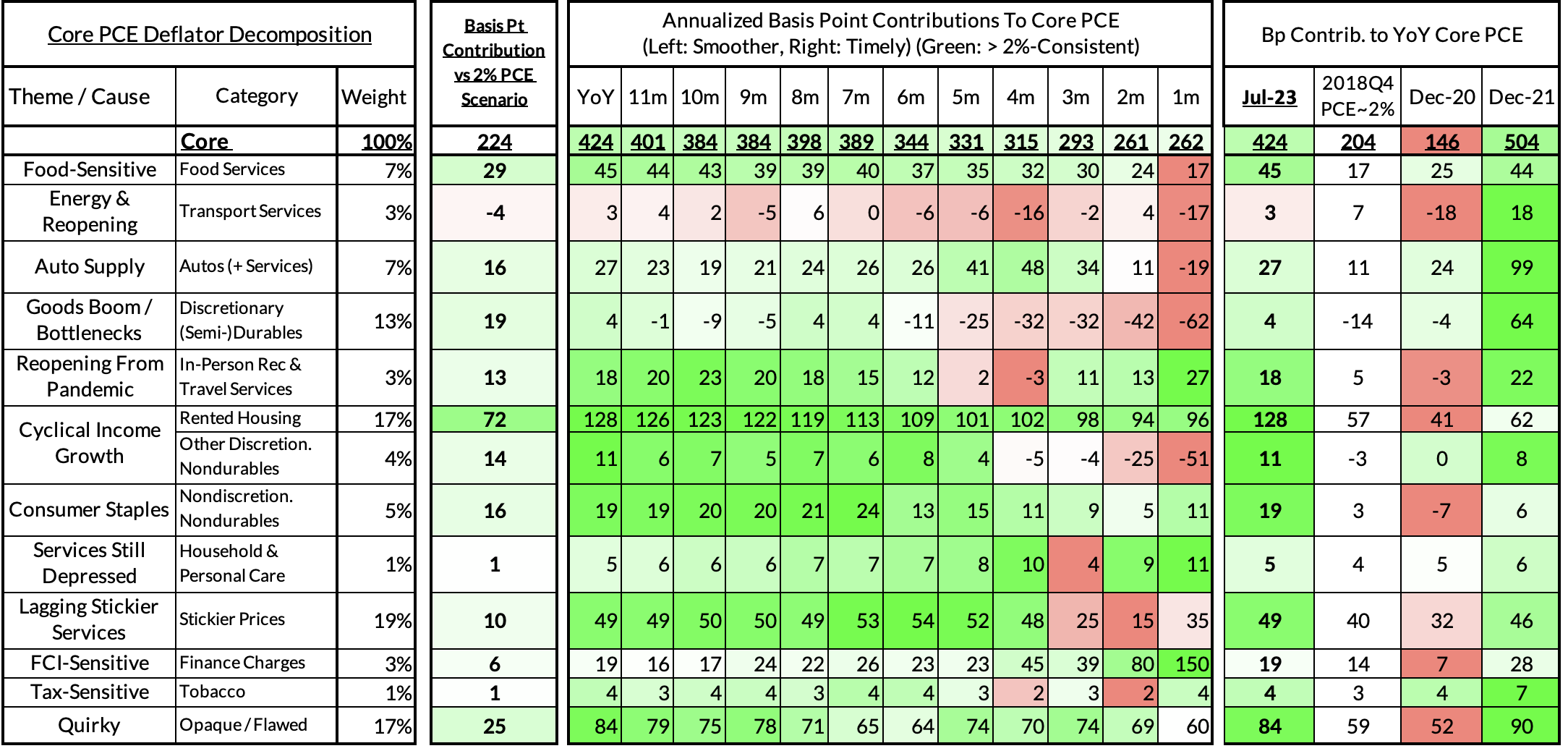
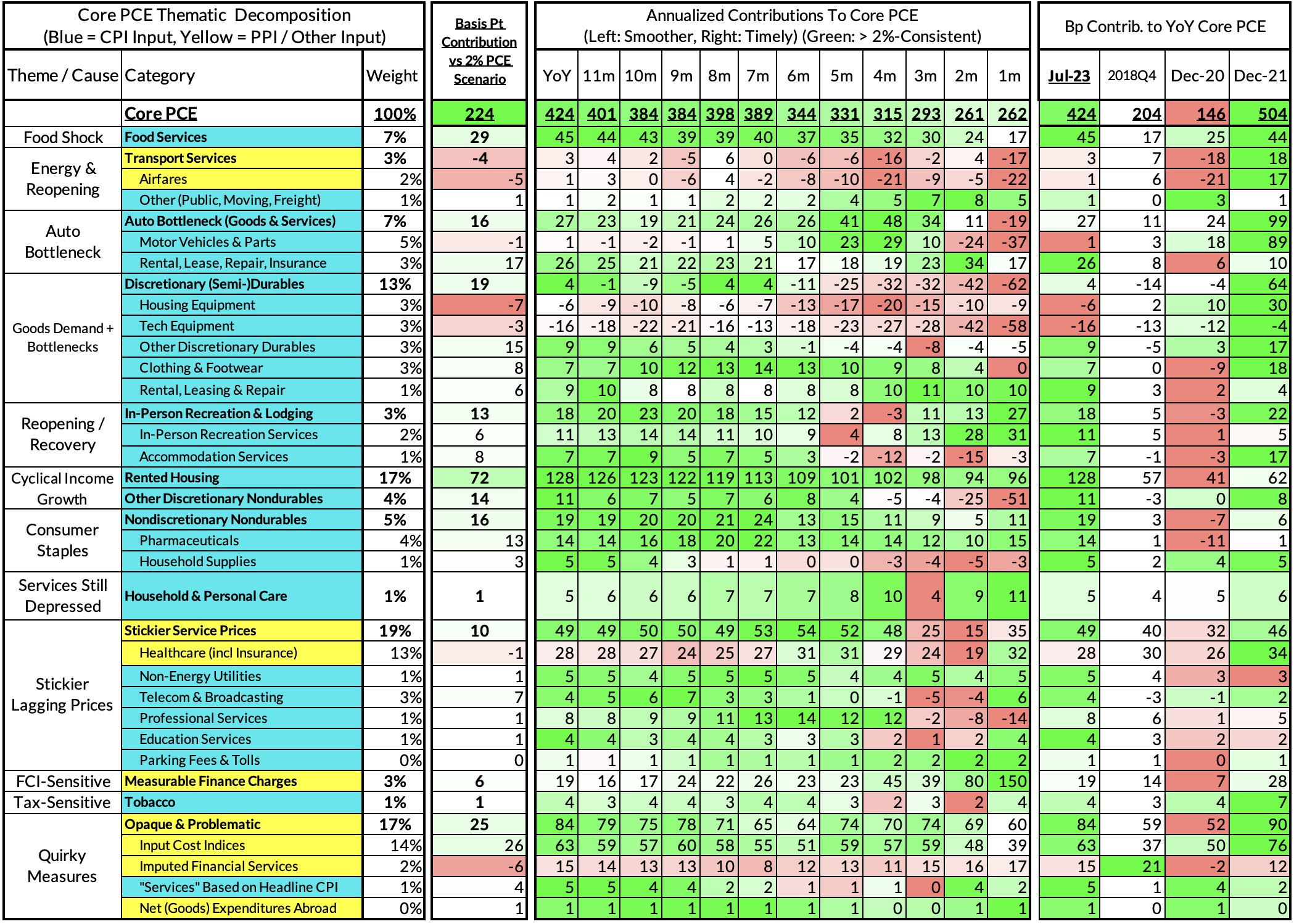
The final two heatmaps of this section give you a sense of the overshoot on shorter annualized run-rates. Monthly annualized core PCE in July yielded a 2.62% now likely yields a 62 basis point overshoot vs 2% target inflation (2.62% annualized).
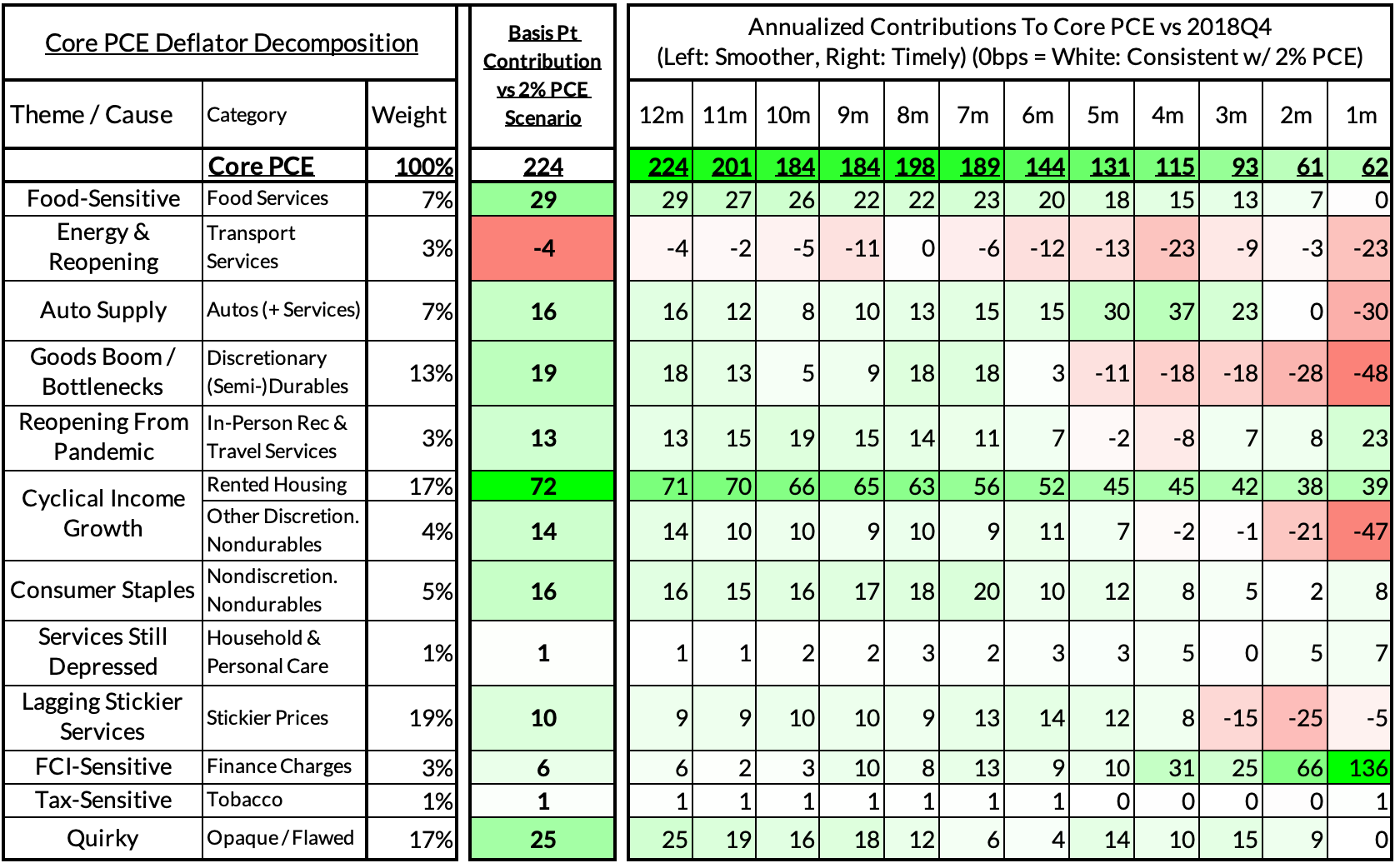
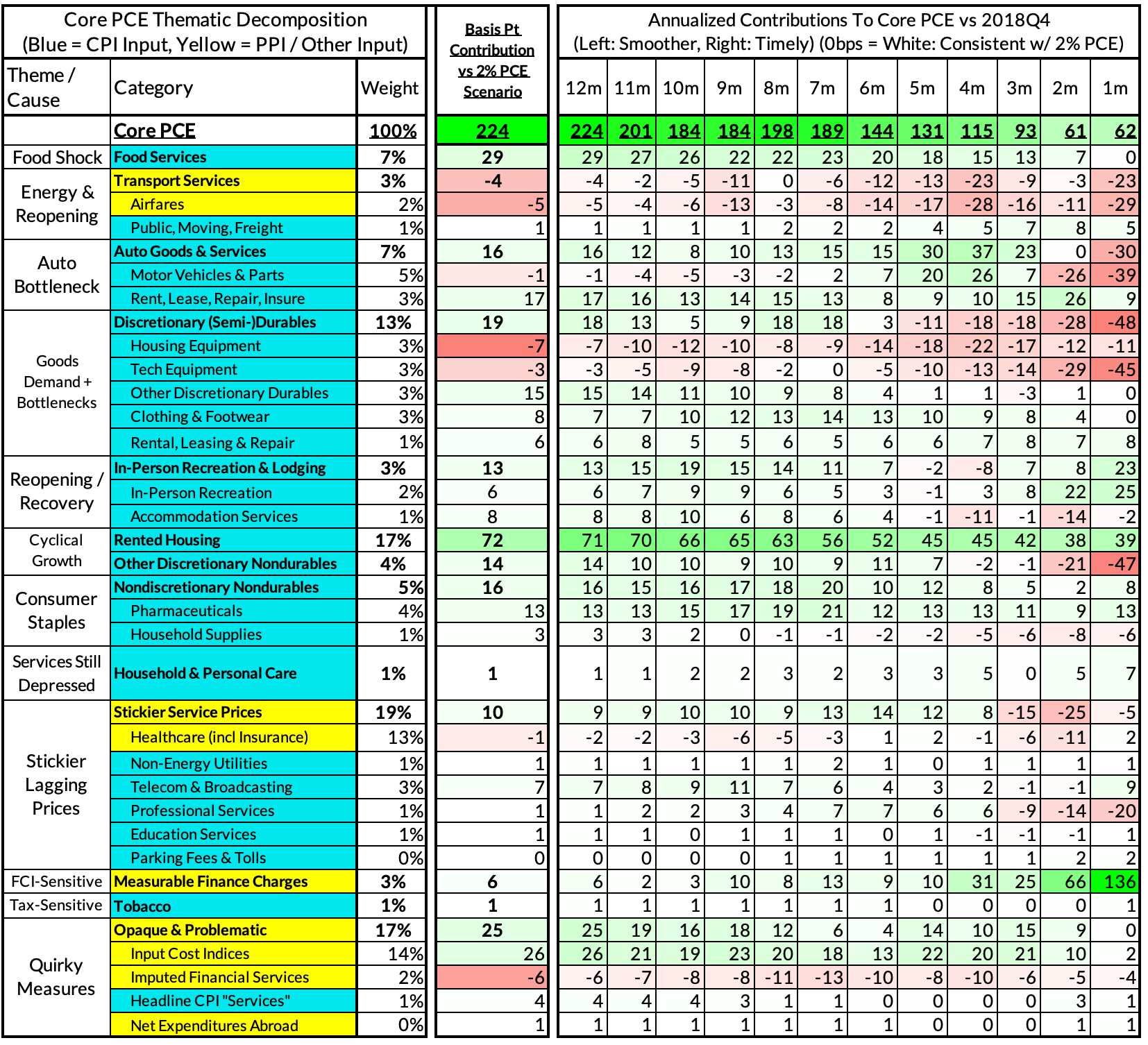
For the Detail-Oriented: Core Services Ex Housing PCE Heatmaps
The July growth rate in "Core Services Ex Housing PCE" ran at 4.70%, a 202 basis point overshoot versus the 2.68% run rate that coincided with ~2% headline and core PCE.
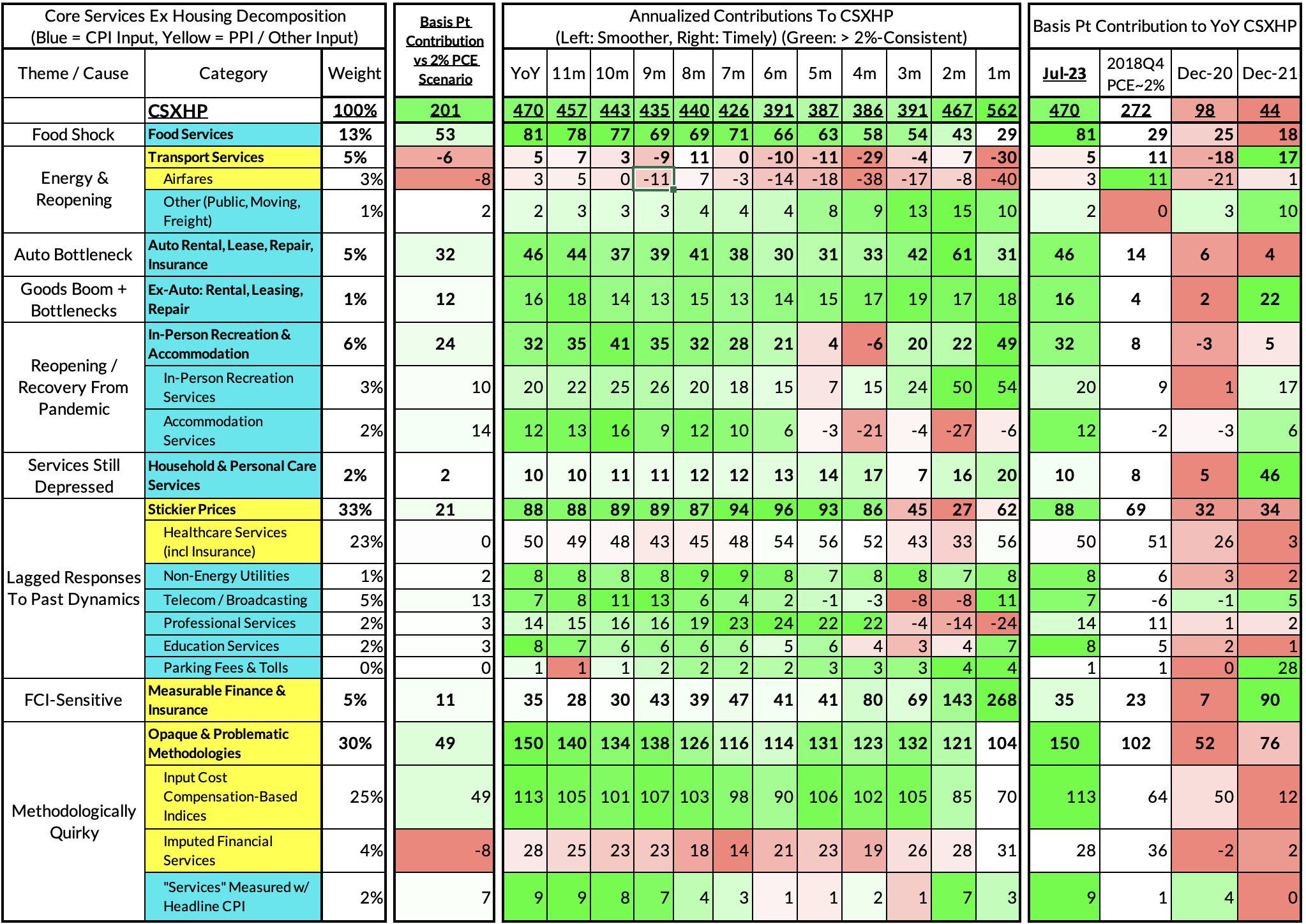
The momentum for deceleration in this subaggregate of PCE has been temporarily arrested by a surge in portfolio management and investment advisory prices. July monthly CSXHP ran at a 5.62% annualized rate, a 294 basis point overshoot of what would be consistent with 2% headline and core PCE. Over the coming months, we should see more progress as PCE-specific idiosyncraasies abate (and even as CPI-specific idiosyncrasies ramp up).
